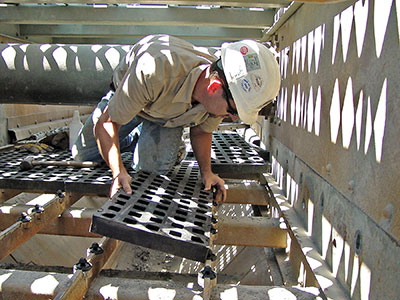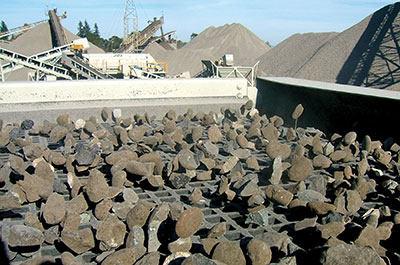
Features
Aggregates
Profiles
Investing in Noise Reduction
Ontario quarry uses screen media solution to meet noise requirements.
February 12, 2014 By Carol Wasson
Synthetic screen media is allowing more and more operations to stay
ahead of increasingly stringent noise-related regulations – and it’s
also allowing them to boost quality control levels.
Synthetic screen media is allowing more and more operations to stay ahead of increasingly stringent noise-related regulations – and it’s also allowing them to boost quality control levels. That’s especially good news for operations concerned about the recently updated Environmental Noise Guideline (NPC-300) in Ontario. While it is not a remedy for every noise reduction challenge, the right synthetic screen media can be a very viable and affordable option in bringing operations into compliance.
 |
|
| The modular media solution provided by Polydeck allowed for an efficient conversion from the wire cloth originally in place on the deck.
|
When a southern Ontario-based quarry installed modular synthetic rubber screen media panels to replace wire cloth on a new secondary circuit, its major motivation was noise reduction. The operation runs three crushers – a Metso jaw crusher, a Nordberg secondary impact crusher and a Sandvik cone crusher – to produce rock for roadbuilding and cement operations. The screen system includes three Terex Simplicity screens, with a triple-deck primary, triple-deck classification, and double-deck fines screen all used in the aggregate production.
Committed to being a good neighbour to those who surround its operations, the quarry’s site supervisor is happy to say that the crew can actually stand next to the twin classifying screens and have a normal conversation. Fast-forward four years after the installation, and the crew found that the synthetic media had delivered far more than quieter processing. In fact, they realized they had yet to change out any screen panels on the classifiers. More importantly, their specs were still on the money, and they had significantly reduced any maintenance downtime. Consequently, they decided to run synthetic media throughout the whole plant – including on their primary circuit where they had been continuously changing out wire cloth on a weekly basis for many years.
Specifying Synthetic Media
When the operation added a new secondary plant, its management team consulted with Polydeck Screen Corporation on choosing the right synthetic media for its twin 8 ft. x 20 ft. triple-deck classifying screens. Polydeck’s Eastern aggregate industry manager, Dave Ciszczon, and the applications engineering team at the manufacturing plant worked with the site personnel to conduct a thorough analysis of the application and to specify the right panel types, sizes and openings to best meet the desired gradations – and the noise reduction requirements.
Ciszczon and his team suggested that the quarry install Polydeck’s Modular Rubberdex® Flexi panels, specified in a wide range of opening shapes and sizes. The Flexi panel design addresses the fines content in a dry screening application while preventing any blinding or pegging on the bottom decks where fine sizing occurs. “The synthetic rubber-formulated panels provide a significant reduction in noise levels over that of traditional wire cloth, which typically registers at 105 decibels or higher. Alternatively, our synthetic rubber media typically produces approximately 96 decibels in similar running conditions – a level the human ear registers as a 50 per cent reduction in sound,” says Ciszczon.
Long Wearlife Advantages
While the initial cost of modular synthetic rubber panels exceeds that of traditional wire cloth, the operation found that it is the far longer wearlife of synthetic media that provides the payback. Regarding the prior weekly wire cloth changeouts, the operation found them labour and cost-intensive. They had to shut down for a couple of hours each time and have two to three workers carrying each 4 ft. x 8 ft. wire cloth panel up or down the screen tower stairs – and as it was always hard to get around the corners with wire screens, the crew was subject to getting hands and arms nicked by the wire edges.
 |
|
| The modular media panels in action in the horizontal scalping application at the quarry.
|
With the modular synthetic rubber panels, maintenance workers have to replace only one or two panels, versus changing out an entire wire cloth panel. Based on the company’s previous experience, they knew that one worker can safely and easily carry up to four 1 ft. x 2 ft. panels up to the screens during any changeout. Plus, when changing wire panels out after just a week or less, material was being wasted. Ultimately, the synthetic media has significantly reduced downtime and maintenance costs, providing a quick return on investment.
“With the addition of a new 7 ft. x 20 ft., double-deck wash plant, this operation will be utilizing a configuration of the company’s specially formulated modular polyurethane panels, which are ideal for use on wet decks,” says Alex Caruana, Polydeck’s Ontario regional manager, adding that at that point the operation will represent a total use of synthetic screen media.
Caruana explains that the conversion is approached as simply as possible with minimal time and expense involved. He says that Polydeck offers its PipeTop II™ frame system with unique half-inch-wide attachment rails. “This provides maximum open area, unlike typical media systems with mounting styles that create up to three inches of dead space where fines may build up. The cost of the conversion is minimal especially when considering the returns gained from the flexibility and life span of synthetic media versus other media types,” he stresses.
In addition to the cost savings, synthetic media allows continual quality control. When using wire cloth, the operation found that if they blew a hole in it and did not catch it right away, they had oversize in the product stockpiles. With modular synthetic panels, the crew has time to catch any wear issues before they become a problem. For example, the QC team can identify if production is slightly off on its #1 sieve perhaps – allowing the crew to start gauging its screens and checking for any wear. After this routine maintenance, they simply take a few minutes to change out a panel or two, and they are up and
running again.
Noise Regulation Compliance
Currently under discussion at many industry meetings are the yet unknowns about how the updated NPC-300 noise regulation will affect operations now and into the future. “While new aggregate application licences granted after August 2013 are clearly subject to the updated ordinance, existing quarries that undergo significant expansions or upgrades may also be affected,” says Polydeck’s Caruana. “For example, the regulations could require increased berm heights, a situation that may not be possible due to the footprint of the site or would be extremely costly,” he stresses, adding that the ordinance increases the noise measuring requirements to include one- to three-storey structures near quarry sites, as well as vacant lots that abut the property.
“The right synthetic screen media can bring you into compliance, particularly if the operation is just a few decibels away from meeting the test requirements – and it is certainly a far less expensive alternative versus increasing berm heights or building structures around processing circuits,” says Caruana. “While synthetic media will not be a total solution for every situation, it is a very viable option for those on the cusp of meeting the regulations,” he says.
This story was written by Carol Wasson for Polydeck Screen Corporation and edited for use in Rock to Road by Andrew Macklin.
Print this page